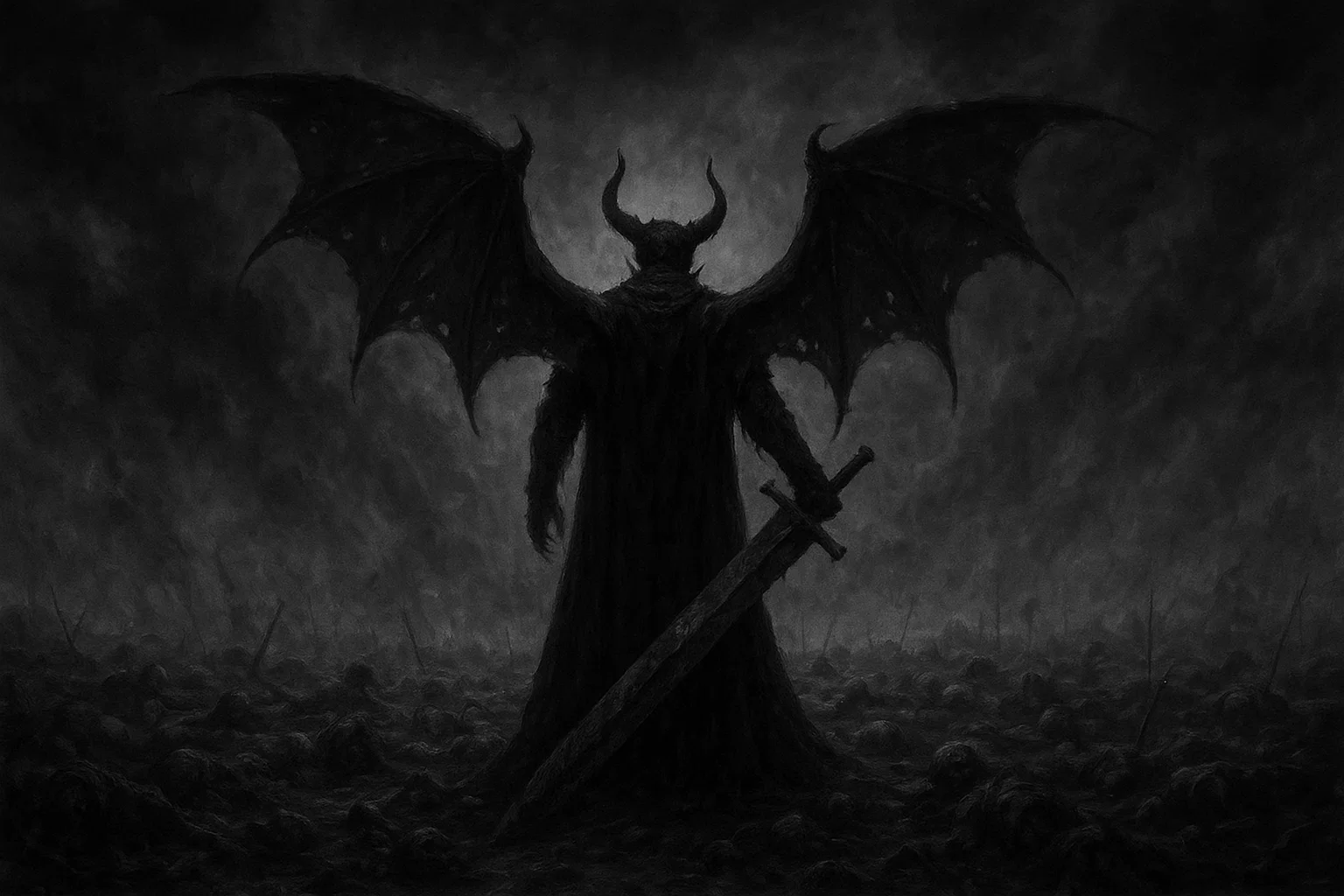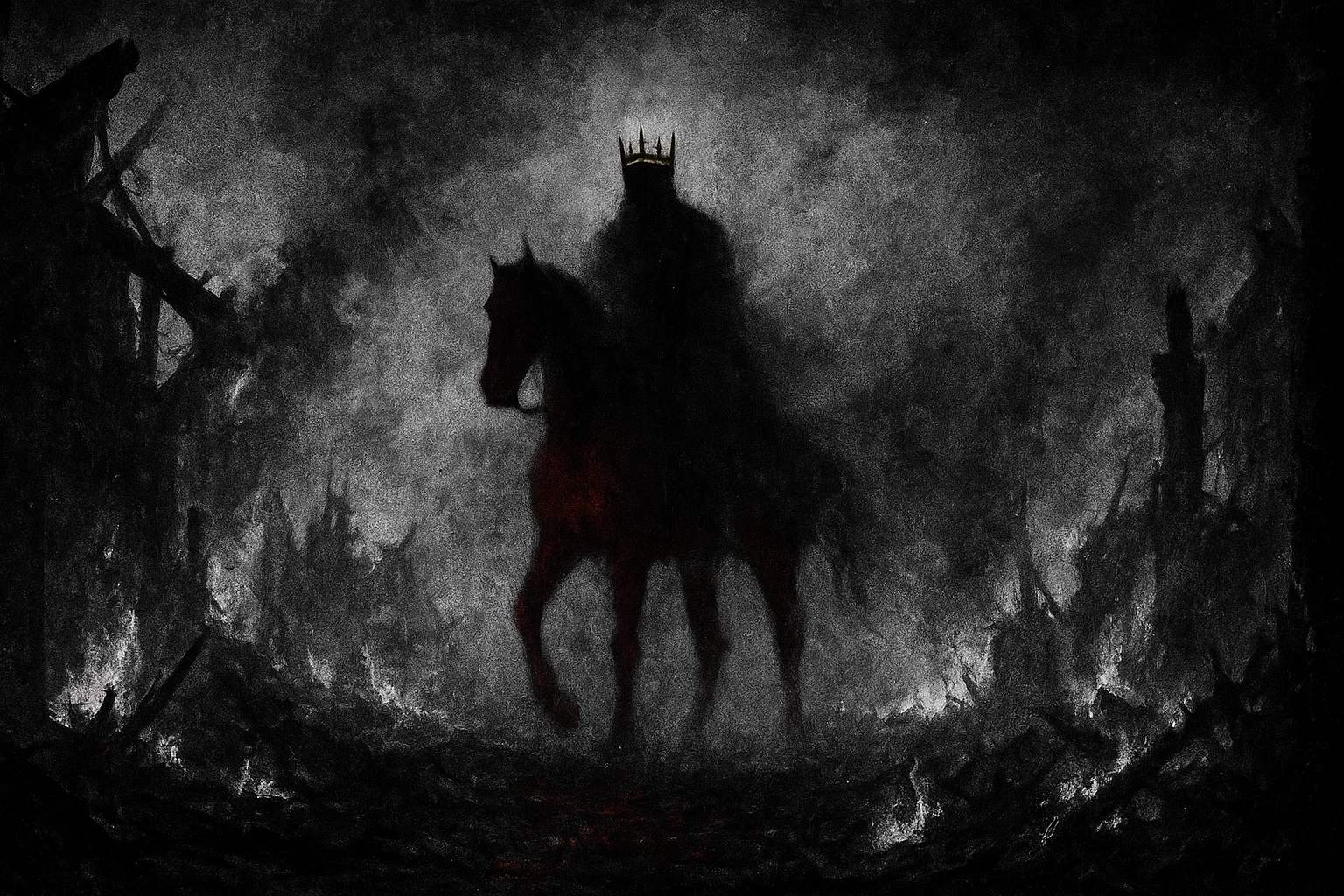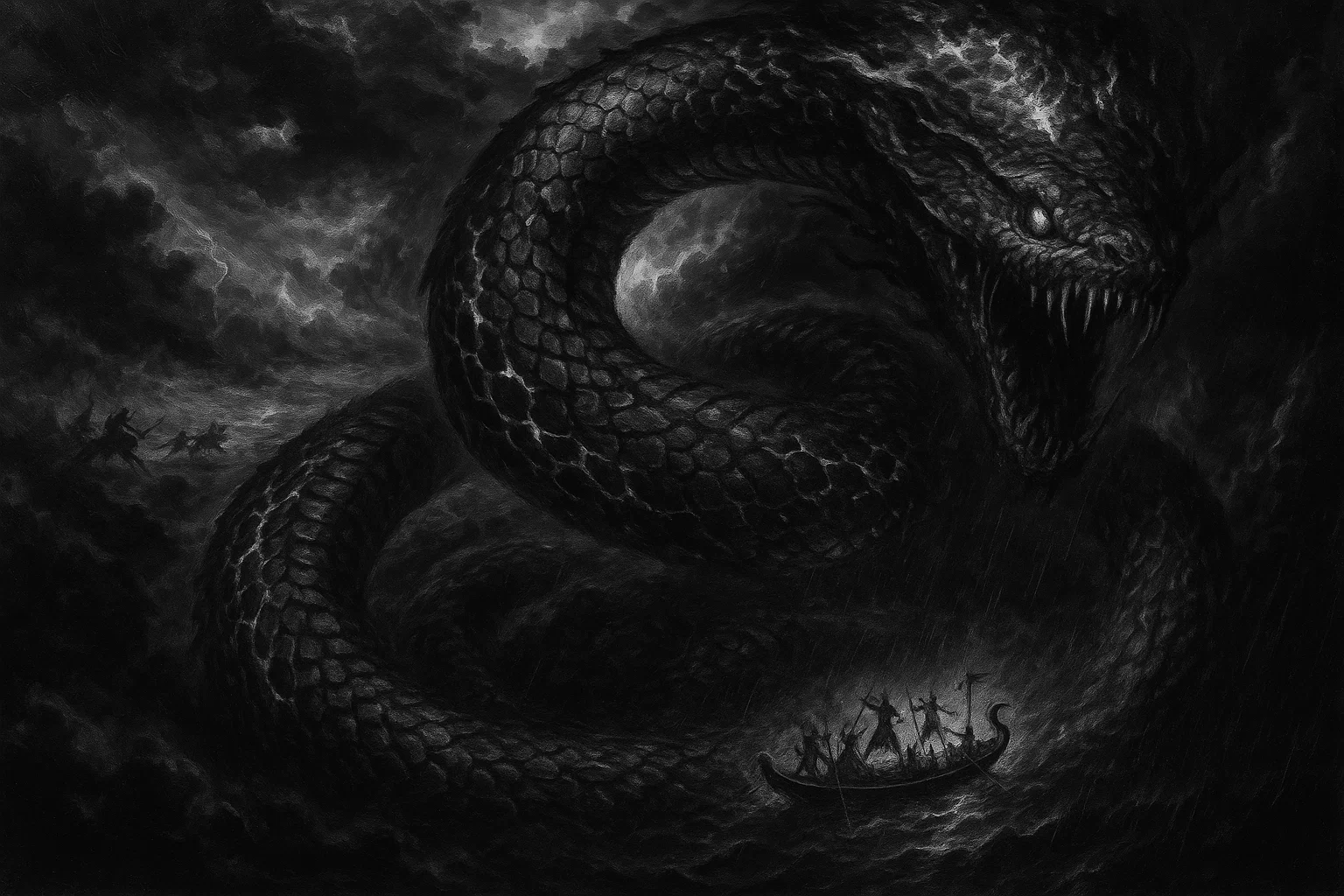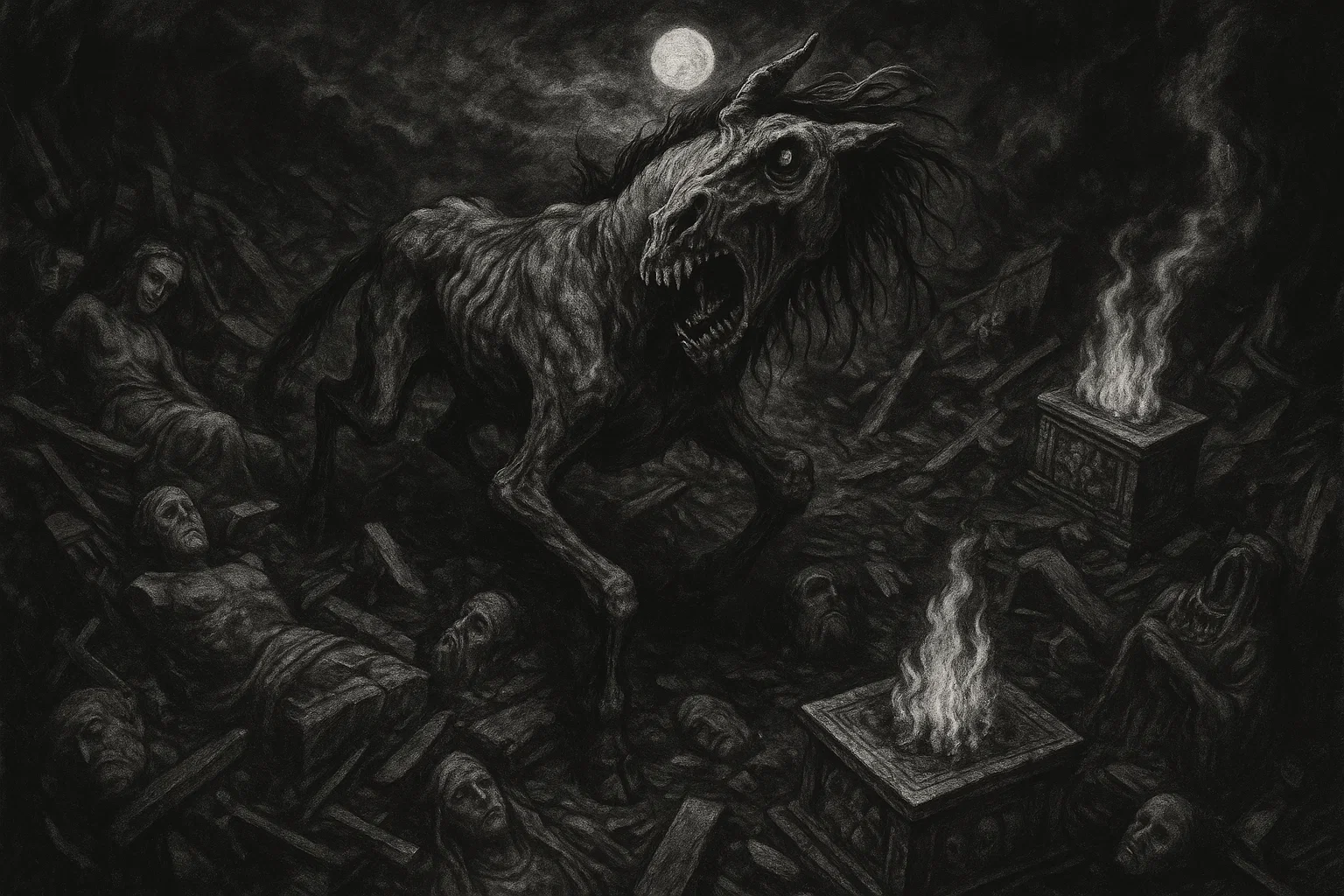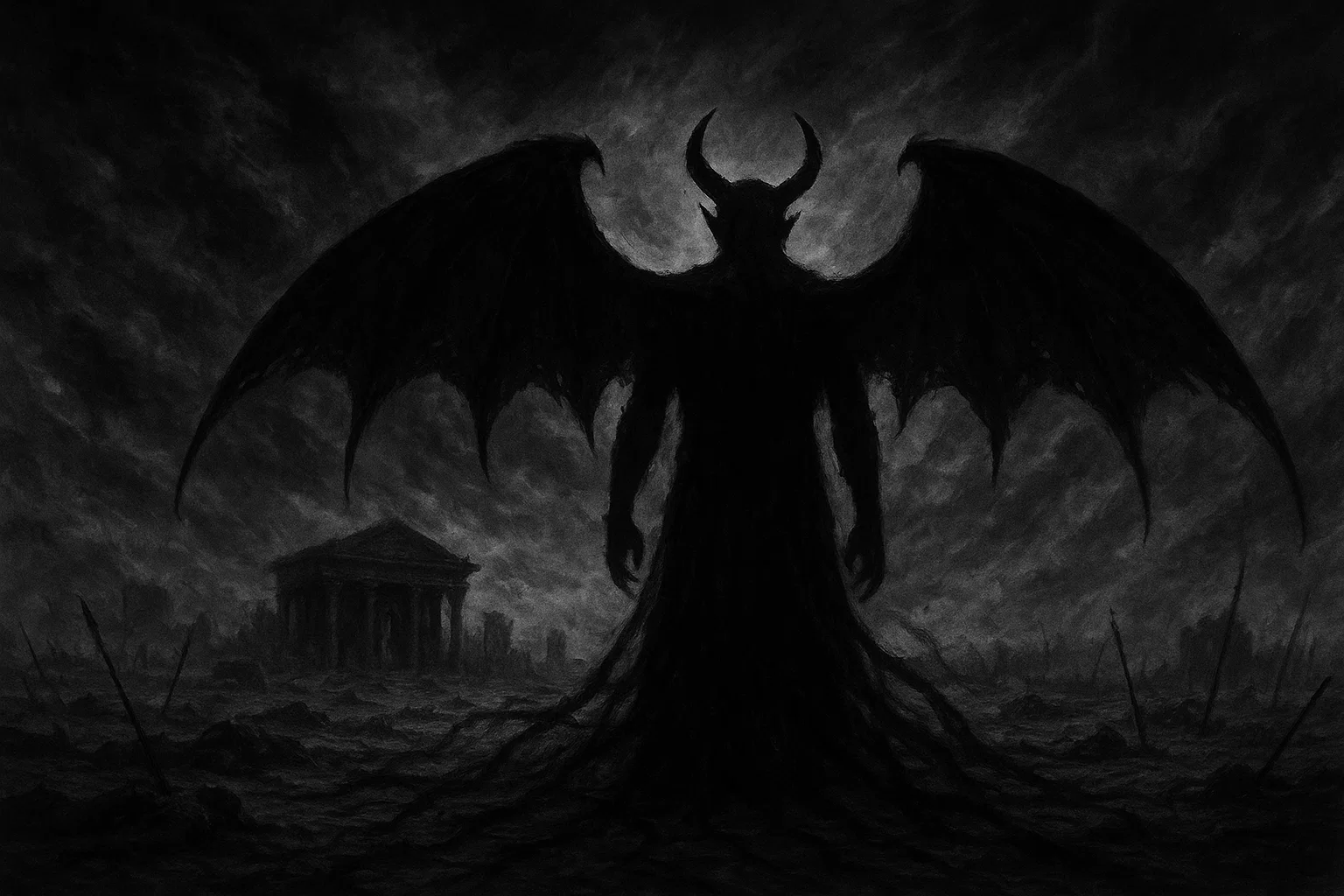In the shadowed depths of Greek mythology and Christian demonology, Alastor emerges as a malevolent force, a demon whose name evokes retribution, blood feuds, and infernal torment. Known as the avenger or executioner of Hell, this sinister entity thrives on perpetuating cycles of vengeance and familial curses, ensuring that no sin escapes his cruel grasp.
What drives this daimon to haunt generations with relentless punishment? How does his influence extend from ancient myths to modern occult lore, and what makes him a uniquely terrifying figure in the hierarchy of Hell?
Alastor’s legacy is one of unyielding wrath, where the sins of the past fuel endless torment for the living and the damned alike. From his origins as a spirit of vengeance in Greek lore to his evolution into a high-ranking demon in Christian grimoires, Alastor embodies the darkest aspects of justice—twisted into malevolence. Can humanity escape his infernal gaze, or are we doomed to repeat the cycles of hatred he orchestrates?
This exploration uncovers the chilling truths behind Alastor’s mythology, powers, and cultural significance. Prepare to delve into a world where retribution knows no bounds, and the demon Alastor reigns as a merciless enforcer of divine and infernal wrath.
Table of Contents
Key Information
| Attribute | Details |
|---|---|
| Name | Alastor, Alastoros, Ἀλάστωρ (Greek), The Executioner, Evil Genius of the Household |
| Title | Spirit of Vengeance, Avenger, Executioner of Hell, Demon of Blood Feuds, Tormentor |
| Gender | Male |
| Role | Enforcer of familial vengeance, executioner in Hell, instigator of blood feuds |
| Hierarchy | High-ranking archdemon, chief executioner under Satan or Lucifer |
| Servitors | Lesser demons of rage and torment, unnamed infernal torturers |
| Superior Demon | Satan, Lucifer |
| Powers | Inciting vengeance, demonic possession, perpetuating blood feuds, tormenting souls, shadow manipulation, curse amplification |
| Appearance | Skeletal figure in dark robes, glowing red eyes, bat-like wings, wielding a sword or whip |
| Etymology | From Greek “Ἀλάστωρ,” meaning “avenger” or “one who does not forget” |
| Associated Figures | Zeus (epithet), Nemesis, Erinyes (Furies), Tantalus, Orestes, Clytemnestra, Nyx, Erebus |
| Weaknesses | Exorcism, Psalms of Protection (e.g., Psalm 91), forgiveness, holy relics |
| Opposing Angel/Saint | Archangel Michael, Saint Benedict, Saint Anthony |
| Equipment/Tools | Sword, whip, chains, scales of justice, cursed relics |
| Pantheon | Greek Mythology, Christian Demonology, Roman Mythology |
Etymology
The name Alastor derives from the Ancient Greek term Ἀλάστωρ (Alastôr), meaning “avenger” or “one who does not forget.” The root ala- is linked to notions of wandering or unrest, reflecting Alastor’s relentless pursuit of vengeance across time and generations.
In early Greek texts, alastor was a fluid term, applied to deities like Zeus (as Zeus Alastor), spirits, or even mortals driven by divine wrath. Its connotation of unforgettable retribution underscores Alastor’s role as a punisher of familial sins and blood feuds.
By the 4th century BC, the term alastor had degraded into a colloquial insult, meaning “scoundrel” or “wretch,” yet its mythological weight persisted in Greek tragedies. In Christian demonology, the name took on a darker hue, signifying a demon of cruelty and execution.
Scholars like Hesychius of Alexandria and the Etymologicum Magnum connect Alastor to Nemesis and the Erinyes, reinforcing his role as a personification of curses. The name’s evolution mirrors Alastor’s transformation from a divine enforcer to a malevolent entity, embodying retribution twisted into sadistic torment.
In occult traditions, Alastor’s name is sometimes linked to Azazel, a fallen angel associated with scapegoating and punishment, suggesting a broader etymological resonance across cultures.
The linguistic journey of Alastor also finds echoes in other languages. In Sanskrit, the term alas (meaning “lazy” or “restless”) shares phonetic similarities, potentially hinting at a shared Indo-European root for unrest or pursuit. This connection, while speculative, underscores Alastor’s universal appeal as a symbol of unrelenting justice. In modern contexts, the name’s use in literature, such as Percy Bysshe Shelley’s Alastor; or, The Spirit of Solitude (1816), further cements its association with torment and isolation, reflecting the demon’s enduring cultural impact.
You May Also Like: Is Ahriman the Oldest Demon in History?
What Does the Demon Alastor Look Like?
Alastor is a terrifying figure in demonology, depicted as a skeletal entity shrouded in tattered, dark robes that seem to absorb light. His glowing red eyes burn with an otherworldly intensity, symbolizing his unyielding focus on retribution. In some accounts, he sports bat-like wings, enabling swift movement between the mortal world and Hell.
His form is often adorned with symbols of punishment, such as a heavy sword or whip, which he wields with merciless precision. Chains or scales of justice may hang from his frame, emphasizing his role as an executioner. In occult art, Alastor’s skeletal visage and eerie presence evoke a wraith-like quality, with some descriptions noting a shadowy aura that shifts and writhes, amplifying his menacing demeanor.
Historical and Mythological Background
Alastor’s origins span Greek mythology, Roman traditions, and Christian demonology, evolving from a daimon of familial vengeance to a high-ranking demon of infernal torment. His narrative is steeped in tales of blood feuds, curses, and divine retribution, with connections to deities and spirits across cultures. Below are detailed accounts of myths and legends featuring Alastor, alongside potential links to other ancient entities.
Origins and Cross-Cultural Connections
In Greek mythology, Alastor emerged as a spirit of vengeance, often associated with Zeus (as Zeus Alastor) and the Erinyes (Furies), who punished murderers and oath-breakers. His role as a personification of curses tied him to familial sins, ensuring that the crimes of ancestors haunted their descendants.
This concept of generational retribution finds parallels in other cultures. In Mesopotamian mythology, the edimmu—vengeful spirits of the unburied dead—share Alastor’s focus on posthumous justice. Similarly, in Hindu mythology, the pitrs (ancestral spirits) could curse families for neglecting rituals, echoing Alastor’s familial vengeance.
In Zoroastrianism, Alastor’s role as a tormentor aligns with Aeshma, the demon of wrath who incites violence and rage. Early Christian scholars, such as Origen, linked Alastor to Azazel, a fallen angel associated with scapegoating and punishment in Jewish demonology.
These connections suggest that Alastor’s archetype as an avenger transcends cultural boundaries, rooted in humanity’s fear of unresolved sins. In Roman mythology, the genius of the household, when angered, could incite violence, mirroring Alastor’s role as the Evil Genius of the Household.
You May Also Like: Who Is Abezethibou? The Fallen Angel of the Red Sea
The Curse of the House of Atreus
The House of Atreus saga, detailed in Aeschylus’s Oresteia (458 BC), is a cornerstone of Alastor’s mythology. The curse begins with Tantalus, who offends the gods by serving his son Pelops as a meal. Alastor, as a daimon of familial retribution, ensures that Tantalus’s descendants—Atreus, Thyestes, Agamemnon, and Orestes—suffer for this sin.
Atreus slaughters Thyestes’ sons, serving them as a meal, and Alastor’s influence perpetuates the blood feud. Clytemnestra murders Agamemnon for sacrificing their daughter Iphigenia, and Orestes, driven by Alastor’s vengeful whisper, kills his mother, only to be pursued by the Erinyes. This cycle of violence underscores Alastor’s role as a relentless enforcer of retribution, trapping families in endless suffering.
The Myth of Orestes
In Euripides’ Electra (413 BC), Alastor is a malevolent force questioning the morality of Orestes’ actions. After Clytemnestra and Aegisthus murder Agamemnon, Alastor incites Orestes to commit matricide, perpetuating the curse. Orestes wonders if the oracle urging this act comes from Apollo or a malicious alastor, highlighting the demon’s deceptive nature.
The Erinyes, closely tied to Alastor, torment Orestes with madness, illustrating his power to drive individuals to violent retribution and subsequent despair. This myth emphasizes Alastor’s ability to manipulate human emotions, turning justice into tragedy.
Tantalus’s Eternal Torment
The myth of Tantalus further showcases Alastor’s role in divine punishment. After Tantalus’s sacrilege, Alastor ensures his eternal torment in the Underworld, where he stands in water beneath a fruit tree, unable to drink or eat.
This punishment extends to his descendants, with Alastor orchestrating the House of Atreus’s blood feuds. The daimon’s presence ensures that Tantalus’s sin reverberates through generations, a testament to his power to enforce generational curses.
Alastor in the Trojan War
In Homer’s Iliad (8th century BC), Alastor appears as a mortal warrior, a Lycian companion of Sarpedon, slain by Odysseus during the Trojan War. While distinct from the daimon, this Alastor’s death fuels vengeance among the Lycians, aligning with the spirit’s theme of retribution.
Another Alastor, a Pylian soldier under Nestor, aids in rescuing wounded warriors, suggesting a symbolic connection to the avenger archetype, as his actions contribute to the cycle of violence in the war.
Alastor as a Son of Neleus
In some myths, Alastor is a mortal son of Neleus, king of Pylos, and Chloris. Alongside his brothers, he is killed by Heracles during the sack of Pylos. After death, Alastor is downgraded to a minor daimon, retaining his vengeful nature.
This transformation mirrors his later demonic role in Christian demonology, where he becomes a tormentor of the damned, reflecting the fluidity of his identity across traditions.
You May Also Like: Abalam: Demon of Sorrow and Knowledge
Alastor in Christian Demonology
In Christian demonology, Alastor evolves into a high-ranking archdemon, known as the Executioner of Hell. Collin de Plancy’s Dictionnaire Infernal (1818) describes him as a cruel enforcer under Satan, tasked with torturing souls and inciting possession. His role as a demon of blood feuds persists, with Alastor targeting families to perpetuate cycles of violence.
Some traditions rumor that Alastor was once a Destroyer Angel, cast into Hell for his heinous deeds, akin to Merihem or Azazel. This origin story enhances his malevolent reputation, emphasizing his sadistic nature.
Connections to Other Deities and Demons
Alastor’s archetype resonates with deities and demons across cultures. In Egyptian mythology, Sekhmet, the lioness goddess of war and retribution, shares Alastor’s thirst for violent justice.
In Norse mythology, the valkyries, particularly those like Gunnr (war), embody a similar vengeful spirit, choosing warriors for death in battle.
In Slavic mythology, the rusalka—vengeful water spirits—mirror Alastor’s focus on posthumous retribution. These parallels highlight Alastor’s universal role as an enforcer of consequences, adapted to fit each culture’s understanding of justice and punishment.
Historical Mentions
| Text/Grimoire | Year | Description | Excerpt |
|---|---|---|---|
| Aeschylus, Agamemnon | 458 BC | Alastor as a daimon driving familial vengeance in the House of Atreus. | “O Daimon [Alastor] who falls upon this house and Tantalos’ two descendants… the thrice-gorged Daimon of this race.” |
| Euripides, Electra | 413 BC | Alastor as a malevolent spirit influencing Orestes’ matricide. | “Was it some alastor that spoke, and not Apollo’s oracle?” |
| Homer, Iliad | 8th c. BC | Alastor as a Lycian warrior slain by Odysseus, tied to vengeance cycles. | “Odysseus slew… Alastor, Chromius, Alcandrus…” |
| Dictionnaire Infernal by Collin de Plancy | 1818 | Alastor as a high-ranking demon, the Executioner of Hell, linked to Nemesis. | “Alastor is likened to Nemesis and the destroying angel and is known as The Executioner.” |
| Alastor; or, The Spirit of Solitude by Percy Bysshe Shelley | 1816 | Alastor as a spirit driving idealists to self-destruction through solitude. | “Alastor, or The Spirit of Solitude, warns idealists not to abandon sweet human love.” |
Alastor’s Powers and Abilities
Alastor’s powers are uniquely tied to his role as a demon of vengeance, setting him apart from other demons who rely on lust, greed, or deception. His abilities focus on rage, retribution, and generational curses, making him a formidable force in both the mortal and infernal realms.
In modern pop culture, Alastor’s powers have been reimagined, particularly in media like Hazbin Hotel, where he is depicted with radio-based abilities and charismatic manipulation, though these are secondary to his traditional demonic traits.
Core Powers
- Inciting Vengeance: Alastor plants seeds of revenge in human minds, amplifying anger and resentment to drive violent acts. He targets familial conflicts, ensuring blood feuds persist across generations.
- Demonic Possession: Alastor seizes control of individuals, inducing fits of rage and violent impulses. His possessions are marked by uncontrollable anger, often leading to murder or self-destruction.
- Perpetuating Blood Feuds: Alastor’s curses bind families to cycles of retribution, ensuring that sins of the past haunt descendants. This power amplifies generational trauma, making reconciliation nearly impossible.
- Tormenting the Damned: In Hell, Alastor oversees the torture of souls, tailoring punishments to match their sins. His sadistic methods are described as an art form, reflecting his cruelty.
- Shadow Manipulation: Alastor can summon and control shadows, using them to intimidate, ensnare, or torment victims. This power enhances his eerie presence and mobility.
- Curse Amplification: Alastor strengthens existing curses, making them more potent and enduring. This ability ensures that familial sins remain active, driving further conflict.
You May Also Like: Complete Guide to Washington Bigfoot Sightings (1850–2025)
Pop Culture Powers
In Hazbin Hotel, Alastor, known as the Radio Demon, wields radio-based powers, broadcasting chaos and manipulation through soundwaves. He can distort reality, summon tentacle-like shadows, and use charismatic speech to control others.
While these abilities are fictional, they reflect Alastor’s traditional manipulation and torment in a modern context, emphasizing his deceptive and malevolent nature.
Powers and Abilities Breakdown
| Power/Ability | Description | Source | How It Tempts/Corrupts Humans | Countermeasure |
|---|---|---|---|---|
| Inciting Vengeance | Plants thoughts of revenge, escalating conflicts into violence. | Aeschylus, Agamemnon | Fuels murders and feuds, trapping families in cycles. | Forgiveness, peaceful resolution |
| Demonic Possession | Seizes control, causing rage and violent acts. | Dictionnaire Infernal | Drives individuals to murder or self-harm. | Exorcism, Archangel Michael |
| Perpetuating Blood Feuds | Ensures curses persist across generations, amplifying trauma. | Oresteia | Locks families in endless retribution. | Breaking cycles with forgiveness, Saint Benedict |
| Tormenting the Damned | Oversees cruel punishments in Hell, tailored to sins. | Dictionnaire Infernal | Instills despair, amplifying fear of eternal suffering. | Holy relics, protective rituals |
| Shadow Manipulation | Summons shadows to intimidate or ensnare victims. | Occult traditions | Creates fear, disorients victims into submission. | Light-based rituals, holy water |
| Curse Amplification | Strengthens curses, making them more enduring and potent. | Greek mythology | Deepens familial trauma, preventing healing. | Exorcism, Saint Anthony’s intercession |
How to Counter Alastor’s Powers
Countering Alastor’s malevolent influence requires targeting his vengeful and possessive nature. Exorcism rituals, particularly those invoking Archangel Michael or Saint Benedict, are potent against his possessions.
Reciting Psalms of Protection (e.g., Psalm 91, Psalm 23) disrupts his hold, emphasizing divine protection. Saint Anthony, known for resisting demonic temptation, is another powerful intercessor.
Breaking familial cycles of hatred through forgiveness and reconciliation weakens Alastor’s curses. Protective talismans like crosses, iron, or salt repel his shadowy presence, as these symbolize purity and grounding.
Holy water and blessed objects cleanse spaces of his influence, while rituals of light (e.g., candle ceremonies) counter his shadow manipulation. Resolving conflicts peacefully is crucial, as Alastor thrives on unresolved anger.
Alastor’s Role in the Hierarchy of Hell
In Christian demonology, Alastor is a high-ranking archdemon, serving as the chief executioner under Satan or Lucifer. According to Collin de Plancy’s Dictionnaire Infernal (1818), he rules over a domain of torment in Hell, overseeing the punishment of the damned with unmatched cruelty. His title, Evil Genius of the Household, reflects his ability to infiltrate families, perpetuating curses and feuds.
Alastor commands legions of lesser demons, unnamed servitors who assist in torturing souls and spreading rage. Notable subordinate demons may include spirits of wrath and discord, though specific names are rarely documented.
His superior demons, Satan and Lucifer, delegate infernal justice to him, while allied demons like Abaddon (the Angel of Destruction) and Asmodeus (demon of wrath) share his punitive focus. Adversary demons include Astaroth, who prefers deception over direct violence, and Belial, whose lawlessness clashes with Alastor’s structured retribution.
Alastor’s domain is likely a dark fortress within Hell, filled with chains, torture devices, and shadows. His role parallels Nemesis in Greek mythology, ensuring that sins are met with proportional suffering. His authority places him above dukes like Astaroth but below princes like Beelzebub. His solitary nature limits alliances, as his sadistic focus alienates even other demons.
You May Also Like: Slavic Vampires: The Terrifying Truth About the Upyr
Astrological Associations and Symbolism
Alastor’s astrological and symbolic associations reflect his vengeful and destructive nature. His primary planet, Mars, embodies war, aggression, and retribution, aligning with his role as an executioner.
The zodiac sign Scorpio complements his intense, transformative energy, while the element fire signifies his destructive passion. His number 8 represents cycles, karma, and eternal retribution.
| Astrological/Symbolic Element | Association | Significance |
|---|---|---|
| Planet | Mars | War, aggression, and relentless retribution |
| Zodiac | Scorpio | Vengeance, transformation, and hidden malice |
| Element | Fire | Destruction, passion, and purifying wrath |
| Number | 8 | Cycles, karma, and unending punishment |
| Color | Red, Black | Blood, wrath, and infernal darkness |
| Metal | Iron, Steel | Strength, punishment, and unyielding resolve |
| Crystal | Bloodstone, Obsidian | Protection, vengeance, and grounding malice |
| Day | Tuesday | Ruled by Mars, a day of conflict and action |
| Animal | Raven, Serpent | Omens of death, cunning, and retribution |
Alastor’s Sigil
The Alastor sigil remains elusive in traditional demonology, with no definitive design in historical grimoires. Occult scholars speculate it features geometric shapes like triangles or pentagrams, intertwined with symbols of justice (e.g., scales, swords).
These reflect Alastor’s role as an avenger and executioner. In modern pop culture, such as Hazbin Hotel, his sigil is stylized with radio motifs, though this is non-canonical.
Associated Symbols and Offerings
| Symbol/Item | Association/Meaning | Use in Rituals |
|---|---|---|
| Sword | Retribution, authority | Invoked in summoning for power |
| Scales | Infernal justice, balance | Used in protective rituals against Alastor |
| Bloodstone | Vengeance, protection | Talisman to ward off his influence |
| Myrrh | Infernal connection, purification | Burned in summoning rituals |
| Raven | Death, omens | Symbolic offering to appease Alastor |
| Serpent | Cunning, malice | Used in curses invoking Alastor |
You May Also Like: Resurrection Mary: Chicago’s Most Famous Ghost
Comparison with Other Demons
| Demon | Role | Powers | Hierarchy | Weaknesses |
|---|---|---|---|---|
| Astaroth | Seducer, teacher of sciences | Deception, knowledge | High-ranking duke | Exorcism, holy relics |
| Beelzebub | Lord of Flies, chaos | Corruption, pestilence | Prince, second to Satan | Archangel Michael, holy water |
| Asmodeus | Lust, wrath | Temptation, destruction | King of Demons | Saint Benedict, chastity |
| Abaddon | Angel of Destruction | Annihilation, chaos | High-ranking destroyer | Psalms, divine intervention |
| Belial | Lawlessness, deceit | Manipulation, rebellion | High-ranking prince | Truth, humility |
| Mammon | Greed, wealth | Material temptation | Treasurer of Hell | Charity, spiritual focus |
| Lilith | Seduction, motherhood of demons | Seduction, childbirth harm | Queen of Demons | Protective sigils, exorcism |
| Moloch | Sacrifice, destruction | Demanding child sacrifices | High-ranking prince | Repentance, divine protection |
| Leviathan | Envy, chaos | Deception, aquatic destruction | Admiral of Hell | Humility, holy rituals |
| Baphomet | Occult knowledge, duality | Esoteric wisdom, temptation | Symbolic deity | Clarity, rejection of duality |
Conclusion
Alastor’s chilling presence in Greek mythology and Christian demonology cements his status as a demon of unrelenting vengeance. From his origins as a daimon of familial curses to his role as Hell’s executioner, Alastor embodies the darkest facets of justice—twisted into malevolence. His powers of possession, curse amplification, and shadow manipulation ensure that sins are never forgotten, haunting both the living and the damned.
This exploration reveals Alastor as a symbol of humanity’s struggle with rage and retribution. His myths and legends warn of the dangers of unresolved anger, urging us to break cycles of vengeance through forgiveness. Yet, in the shadows of Hell, Alastor remains an eternal reminder that justice, when corrupted, becomes a tool of torment.

